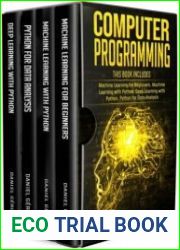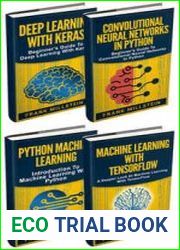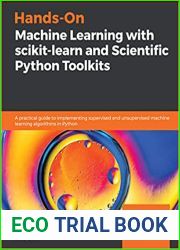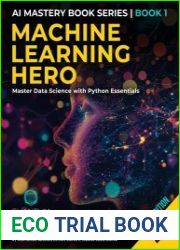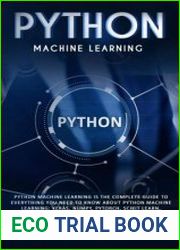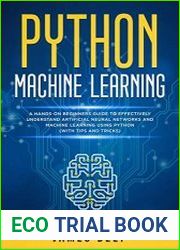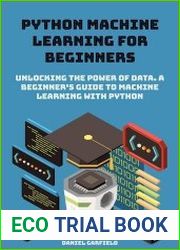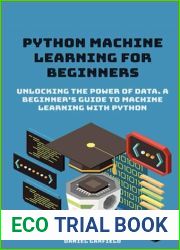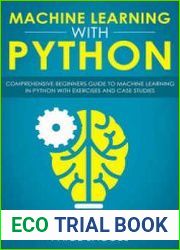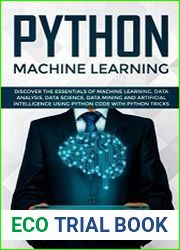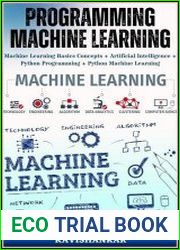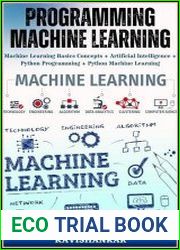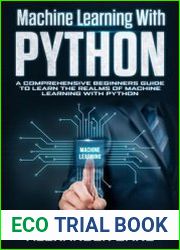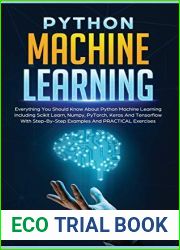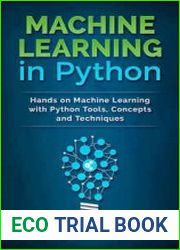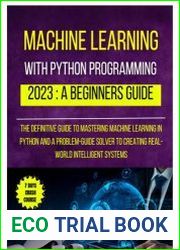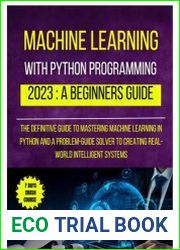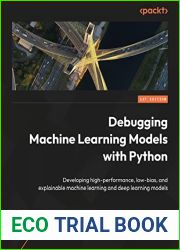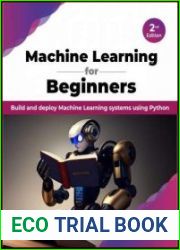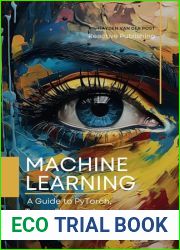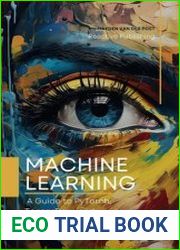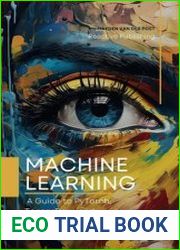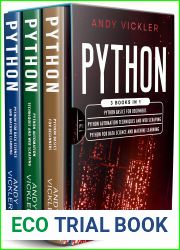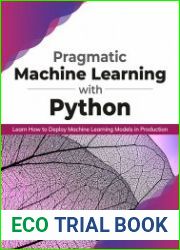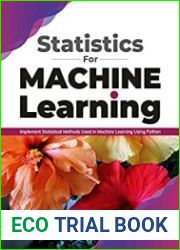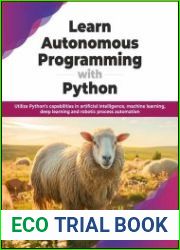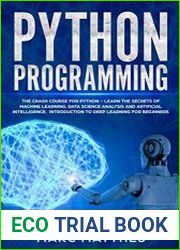
BOOKS - Python 3 and Machine Learning Using ChatGPT / GPT-4

Python 3 and Machine Learning Using ChatGPT / GPT-4
Author: O. Campesato
Year: 2024
Pages: 286
Format: PDF | EPUB
File size: 21.8 MB, 30.3 MB
Language: ENG

Year: 2024
Pages: 286
Format: PDF | EPUB
File size: 21.8 MB, 30.3 MB
Language: ENG

The second part of the chapter delves into the details of Pandas DataFrames and Series. You will learn about the different data types that Pandas supports and how to work with them. You will also learn how to perform basic operations such as selecting rows or columns filtering data and merging datasets. The third part of the chapter explores more advanced topics such as data reshaping and data cleaning. You'll see how to convert categorical variables into numerical variables and vice versa. How to handle missing values and outliers and how to create aggregated data. The fourth part of the chapter covers data visualization using Matplotlib and Seaborn libraries. You'll learn how to create various types of plots and charts and how to customize them to suit your needs. The fifth part of the chapter discusses data manipulation and analysis using GroupBy and merge functions. You'll learn how to group data by various factors and combine multiple datasets. Chapter 2 introduces machine learning classifiers from kNN to SVMs. It begins with an overview of supervised learning and the importance of classification in machine learning. Then it provides code samples for each algorithm and explains how they work. The first part of the chapter covers kNN and its implementation in Python. The second part covers decision trees and random forests. The third part discusses support vector machines and their implementation in Python. The fourth part of the chapter explores more advanced topics such as model evaluation and hyperparameter tuning. The final part of the chapter discusses the use of cross-validation to avoid overfitting. Chapter 3 explores GPT4 capabilities and how they enhance traditional linear regression analysis. It begins with an overview of GPT4 and its capabilities. Then it provides code samples that illustrate some of its features. The first part of the chapter covers text generation and image creation using GPT4.
Вторая часть главы углубляется в детали Pandas DataFrames и Series. Вы узнаете о различных типах данных, которые поддерживает Pandas, и о том, как с ними работать. Вы также узнаете, как выполнять основные операции, такие как выбор строк или столбцов, фильтрация данных и объединение наборов данных. В третьей части главы рассматриваются более продвинутые темы, такие как изменение формы данных и очистка данных. Вы увидите, как преобразовать категориальные переменные в числовые переменные и наоборот. Обработка отсутствующих значений и отклонений, а также создание агрегированных данных. Четвертая часть главы посвящена визуализации данных с помощью библиотек Matplotlib и Seaborn. Вы узнаете, как создавать различные типы графиков и диаграмм и как настроить их в соответствии с вашими потребностями. В пятой части главы рассматриваются манипуляции с данными и их анализ с использованием функций GroupBy и merge. Вы узнаете, как группировать данные по различным факторам и комбинировать несколько наборов данных. Глава 2 вводит классификаторы машинного обучения от kNN до SVM. Он начинается с обзора обучения с учителем и важности классификации в машинном обучении. Затем он предоставляет образцы кода для каждого алгоритма и объясняет, как они работают. Первая часть главы охватывает kNN и его реализацию на Python. Вторая часть охватывает деревья решений и случайные леса. В третьей части обсуждаются поддерживающие векторные машины и их реализация на Python. В четвертой части главы рассматриваются более продвинутые темы, такие как оценка модели и настройка гиперпараметров. В заключительной части главы обсуждается использование перекрестной проверки, чтобы избежать переобучения. Глава 3 исследует возможности GPT4 и то, как они улучшают традиционный линейный регрессионный анализ. Она начинается с обзора GPT4 и его возможностей. Затем он предоставляет примеры кода, которые иллюстрируют некоторые его особенности. Первая часть главы посвящена генерации текста и созданию изображений с помощью GPT4.
La deuxième partie du chapitre est approfondie dans les détails de Pandas DataFrames et Series. Vous en apprendrez plus sur les différents types de données que Pandas prend en charge et sur la façon de travailler avec eux. Vous apprendrez également comment effectuer des opérations de base telles que la sélection de lignes ou de colonnes, le filtrage des données et la fusion des ensembles de données. La troisième partie du chapitre traite de sujets plus avancés, tels que la modification de la forme des données et le nettoyage des données. Vous verrez comment convertir des variables catégoriques en variables numériques et vice versa. Traiter les valeurs et les écarts manquants et créer des données agrégées. La quatrième partie du chapitre est consacrée à la visualisation des données à l'aide des bibliothèques Matplotlib et Seaborn. Vous apprendrez comment créer différents types de graphiques et de graphiques et comment les personnaliser en fonction de vos besoins. La cinquième partie du chapitre traite de la manipulation et de l'analyse des données à l'aide des fonctions GroupBy et merge. Vous apprendrez comment regrouper les données par différents facteurs et combiner plusieurs ensembles de données. chapitre 2 introduit les classificateurs d'apprentissage automatique de kNN à SVM. Il commence par un aperçu de l'apprentissage avec l'enseignant et de l'importance de la classification dans l'apprentissage automatique. Il fournit ensuite des échantillons de code pour chaque algorithme et explique comment ils fonctionnent. La première partie du chapitre couvre kNN et sa mise en œuvre sur Python. La deuxième partie couvre les arbres de décision et les forêts aléatoires. La troisième partie traite des machines vectorielles de support et de leur mise en œuvre sur Python. La quatrième partie du chapitre traite de sujets plus avancés, tels que l'évaluation du modèle et la configuration des hyperparamètres. La dernière partie du chapitre traite de l'utilisation de la vérification croisée pour éviter la réappropriation. chapitre 3 examine les possibilités de GPT4 et la façon dont elles améliorent l'analyse de régression linéaire traditionnelle. Il commence par un aperçu de la GPT4 et de ses possibilités. Il fournit ensuite des exemples de code qui illustrent certaines de ses caractéristiques. La première partie du chapitre est consacrée à la génération de texte et à la création d'images à l'aide d'un GPT4.
La segunda parte del capítulo profundiza en los detalles de Pandas DataFrames y Series. Aprenderá sobre los diferentes tipos de datos que Pandas admite y cómo trabajar con ellos. También aprenderá a realizar operaciones básicas, como seleccionar filas o columnas, filtrar datos y combinar conjuntos de datos. La tercera parte del capítulo aborda temas más avanzados, como el cambio de forma de los datos y la depuración de los mismos. Verá cómo convertir variables categóricas en variables numéricas y viceversa. Procesa los valores y las desviaciones que faltan y crea datos agregados. La cuarta parte del capítulo se centra en la visualización de datos a través de las bibliotecas Matplotlib y Seaborn. Aprenderá cómo crear diferentes tipos de gráficos y gráficos y cómo personalizarlos según sus necesidades. La quinta parte del capítulo trata de la manipulación y el análisis de los datos mediante las funciones GroupBy y merge. Aprenderá a agrupar los datos por diferentes factores y a combinar múltiples conjuntos de datos. capítulo 2 introduce clasificadores de aprendizaje automático desde kNN hasta SVM. Comienza con una revisión del aprendizaje con el profesor y la importancia de la clasificación en el aprendizaje automático. Luego proporciona muestras de código para cada algoritmo y explica cómo funcionan. La primera parte del capítulo cubre kNN y su implementación en Python. La segunda parte abarca los árboles de decisión y los bosques accidentales. En la tercera parte se discuten las máquinas vectoriales de soporte y su implementación en Python. La cuarta parte del capítulo aborda temas más avanzados, como la evaluación del modelo y la afinación de hiperparámetros. En la parte final del capítulo se discute el uso de la verificación cruzada para evitar el readiestramiento. capítulo 3 explora las posibilidades de GPT4 y cómo mejoran el análisis de regresión lineal tradicional. Comienza con una revisión del GPT4 y sus posibilidades. Luego proporciona ejemplos de código que ilustran algunas de sus características. La primera parte del capítulo trata sobre la generación de texto y la creación de imágenes mediante GPT4.
La seconda parte del capitolo viene approfondita nei dettagli di Pandas Serie e Serie. Scopri i diversi tipi di dati supportati da Pandas e come lavorare con loro. Scoprirai anche come eseguire operazioni di base, quali la selezione di righe o colonne, il filtraggio dei dati e l'unione di set di dati. La terza parte del capitolo affronta argomenti più avanzati, come la modifica della forma dei dati e la pulizia dei dati. Vedrai come convertire le variabili categoriche in variabili numeriche e viceversa. Elaborazione di valori e deviazioni mancanti e creazione di dati aggregati. La quarta parte del capitolo è dedicata alla visualizzazione dei dati con Matplotlib e Seaborn. Saprai come creare diversi tipi di grafici e grafici e come personalizzarli in base alle tue esigenze. La quinta parte del capitolo affronta la manipolazione e l'analisi dei dati utilizzando le funzioni GroupBy e merge. Saprete come raggruppare i dati in base a diversi fattori e combinare più set di dati. Il capitolo 2 introduce i classificatori di apprendimento automatico da kNN a SVM. Inizia con una panoramica dell'apprendimento con l'insegnante e l'importanza della classificazione nell'apprendimento automatico. Quindi fornisce campioni di codice per ogni algoritmo e spiega come funzionano. La prima parte del capitolo riguarda il kNN e la sua realizzazione su Python. La seconda parte riguarda alberi di soluzioni e foreste casuali. La terza parte parla delle macchine vettoriali supportate e della loro implementazione su Python. La quarta parte del capitolo affronta argomenti più avanzati, come la valutazione del modello e l'impostazione degli iperparametri. Nella parte finale del capitolo si discute l'uso del controllo incrociato per evitare la riqualificazione. Il capitolo 3 esamina le possibilità di GPT4 e come migliorano le tradizionali analisi lineari di regressione. Inizia con una panoramica di GPT4 e le sue capacità. Fornisce quindi esempi di codice che illustrano alcune delle sue caratteristiche. La prima parte del capitolo è dedicata alla generazione di testo e alla creazione di immagini con GPT4.
Der zweite Teil des Kapitels geht auf die Details der Pandas DataFrames und Series ein. e lernen die verschiedenen Arten von Daten kennen, die Pandas unterstützt und wie e damit arbeiten können. Außerdem erfahren e, wie e grundlegende Operationen wie das Auswählen von Zeilen oder Spalten, das Filtern von Daten und das Zusammenführen von Datensätzen ausführen. Der dritte Teil des Kapitels befasst sich mit fortgeschritteneren Themen wie Formänderung von Daten und Datenbereinigung. e werden sehen, wie man kategoriale Variablen in numerische Variablen umwandelt und umgekehrt. Behandeln e fehlende Werte und Abweichungen und erstellen e aggregierte Daten. Im vierten Teil des Kapitels geht es um die Visualisierung von Daten mit den Bibliotheken Matplotlib und Seaborn. e lernen, wie e verschiedene Arten von Diagrammen und Diagrammen erstellen und wie e sie an Ihre Bedürfnisse anpassen können. Im fünften Teil des Kapitels geht es um die Manipulation von Daten und deren Analyse mit den Funktionen GroupBy und merge. e lernen, wie e Daten nach verschiedenen Faktoren gruppieren und mehrere Datensätze kombinieren. Kapitel 2 führt Klassifikatoren für maschinelles rnen von kNN bis SVM ein. Es beginnt mit einem Überblick über das rnen mit dem hrer und die Bedeutung der Klassifizierung im maschinellen rnen. Es liefert dann Beispielcode für jeden Algorithmus und erklärt, wie sie funktionieren. Der erste Teil des Kapitels behandelt kNN und seine Python-Implementierung. Der zweite Teil umfasst Entscheidungsbäume und Gelegenheitswälder. Im dritten Teil werden unterstützende Vektormaschinen und deren Implementierung in Python diskutiert. Der vierte Teil des Kapitels behandelt fortgeschrittenere Themen wie die Modellbewertung und die Einstellung von Hyperparametern. Im letzten Teil des Kapitels wird der Einsatz von Cross-Check diskutiert, um eine Umschulung zu vermeiden. Kapitel 3 untersucht die Möglichkeiten von GPT4 und wie sie die traditionelle lineare Regressionsanalyse verbessern. Es beginnt mit einem Überblick über die GPT4 und ihre Möglichkeiten. Es liefert dann Codebeispiele, die einige seiner Merkmale veranschaulichen. Der erste Teil des Kapitels konzentriert sich auf die Textgenerierung und die Erstellung von Bildern mit GPT4.
Druga część rozdziału odkłada się na szczegóły dotyczące pandy i serii ramek. Dowiesz się o różnych rodzajach danych Obsługa pandy i jak z nimi pracować. Dowiesz się również, jak wykonywać podstawowe operacje, takie jak wybieranie wierszy lub kolumn, filtrowanie danych i łączenie zbiorów danych. Trzecia część rozdziału dotyczy bardziej zaawansowanych tematów, takich jak zmiana formy danych i rozliczenia danych. Zobaczysz jak konwertować zmienne kategoryczne do zmiennych liczbowych i odwrotnie. Obsługa brakujących wartości i zmienności oraz tworzenie zagregowanych danych. Czwarta część rozdziału poświęcona jest wizualizacji danych za pomocą bibliotek Matplotlib i Seaborn. Dowiesz się, jak tworzyć różne typy wykresów i wykresów oraz jak dostosować je do Twoich potrzeb. Piąta część rozdziału dotyczy manipulacji i analizy danych przy użyciu funkcji GroupBy i scalania. Dowiesz się, jak grupować dane według różnych czynników i łączyć wiele zbiorów danych. Rozdział 2 wprowadza klasyfikatorów uczenia maszynowego od kNN do SVM. Rozpoczyna się od przeglądu nadzorowanego uczenia się i znaczenia klasyfikacji w nauce maszynowej. Następnie dostarcza próbki kodu dla każdego algorytmu i wyjaśnia, jak one działają. Pierwsza część rozdziału obejmuje kNN i jego wdrożenie w Pythonie. Druga część obejmuje drzewa decyzyjne i lasy losowe. Trzecia część omawia obsługę maszyn wektorowych i ich wdrożenie w Pythonie. Czwarta część rozdziału dotyczy bardziej zaawansowanych tematów, takich jak ocena modelu i tworzenie hiperparametrów. Ostatnia część rozdziału omawia wykorzystanie kontroli krzyżowych w celu uniknięcia przekwalifikowania. Rozdział 3 bada możliwości GPT4 i jak poprawiają one tradycyjną liniową analizę regresji. Zaczyna się od przeglądu GPT4 i jego możliwości. Następnie zawiera przykłady kodów, które ilustrują niektóre z jego cech. Pierwsza część rozdziału poświęcona jest generowaniu tekstu i tworzeniu obrazów przy użyciu GPT4.
''
Bölümün ikinci kısmı Pandas DataFrames ve Series'in ayrıntılarına iner. Pandaların desteklediği farklı veri türlerini ve bunlarla nasıl çalışacağınızı öğreneceksiniz. Satır veya sütun seçme, verileri filtreleme ve veri kümelerini birleştirme gibi temel işlemleri nasıl yapacağınızı da öğreneceksiniz. Bölümün üçüncü kısmı, veri biçimini değiştirmek ve verileri temizlemek gibi daha gelişmiş konuları ele almaktadır. Kategorik değişkenleri sayısal değişkenlere nasıl dönüştüreceğinizi ve bunun tersini göreceksiniz. Eksik değerleri ve varyansları işleme ve toplu veriler oluşturma. Bölümün dördüncü kısmı, Matplotlib ve Seaborn kütüphanelerini kullanarak verileri görselleştirmeye ayrılmıştır. Farklı grafik ve grafik türlerini nasıl oluşturacağınızı ve bunları ihtiyaçlarınıza göre nasıl özelleştireceğinizi öğreneceksiniz. Bölümün beşinci kısmı, GroupBy ve birleştirme işlevlerini kullanarak veri manipülasyonu ve analizi ile ilgilidir. Verileri farklı faktörlere göre nasıl gruplandıracağınızı ve birden fazla veri kümesini nasıl birleştireceğinizi öğreneceksiniz. Bölüm 2, kNN'den SVM'ye makine öğrenimi sınıflandırıcılarını tanıtmaktadır. Denetimli öğrenmenin gözden geçirilmesi ve makine öğrenmesinde sınıflandırmanın önemi ile başlar. Daha sonra her algoritma için kod örnekleri sağlar ve nasıl çalıştıklarını açıklar. Bölümün ilk kısmı kNN ve Python uygulamasını kapsar. İkinci bölüm karar ağaçları ve rastgele ormanları kapsar. Üçüncü bölüm, vektör makinelerini ve Python'daki uygulamalarını desteklemeyi tartışıyor. Bölümün dördüncü kısmı, model değerlendirmesi ve hiperparametrelerin kurulması gibi daha gelişmiş konuları ele almaktadır. Bölümün son kısmı, yeniden eğitimden kaçınmak için çapraz kontrol kullanımını tartışmaktadır. Bölüm 3, GPT4 olanaklarını ve geleneksel doğrusal regresyon analizini nasıl geliştirdiklerini inceler. GPT4 ve yeteneklerine genel bir bakış ile başlar. Daha sonra bazı özelliklerini gösteren kod örnekleri sağlar. Bölümün ilk kısmı, metin oluşturmaya ve GPT4 kullanarak görüntüler oluşturmaya ayrılmıştır.
الجزء الثاني من الفصل يتعمق في تفاصيل Pandas DataFrames and Series. ستتعرف على الأنواع المختلفة من البيانات التي تدعمها Pandas وكيفية العمل معها. ستتعلم أيضًا كيفية إجراء العمليات الأساسية مثل اختيار الصفوف أو الأعمدة، وتصفية البيانات، ودمج مجموعات البيانات. ويتناول الجزء الثالث من الفصل مواضيع أكثر تقدما، مثل تغيير شكل البيانات وتطهير البيانات. سترى كيفية تحويل المتغيرات القاطعة إلى متغيرات رقمية والعكس صحيح. معالجة القيم والفروق المفقودة وإنشاء بيانات مجمعة. الجزء الرابع من الفصل مخصص لتصور البيانات باستخدام مكتبتي Matplotlib و Seaborn. ستتعلم كيفية إنشاء أنواع مختلفة من الرسوم البيانية والمخططات وكيفية تخصيصها لاحتياجاتك. ويتناول الجزء الخامس من الفصل التلاعب بالبيانات وتحليلها باستخدام الفريق ودمج الوظائف. ستتعلم كيفية تجميع البيانات حسب عوامل مختلفة ودمج مجموعات بيانات متعددة. يقدم الفصل 2 مصنفات التعلم الآلي من kNN إلى SVM. يبدأ بمراجعة التعلم الخاضع للإشراف وأهمية التصنيف في التعلم الآلي. ثم يوفر عينات رمزية لكل خوارزمية ويشرح كيفية عملها. يغطي الجزء الأول من الفصل kNN وتنفيذ Python. الجزء الثاني يغطي أشجار القرار والغابات العشوائية. يناقش الجزء الثالث دعم الآلات الناقلة وتنفيذها في بايثون. يتناول الجزء الرابع من الفصل مواضيع أكثر تقدمًا مثل تقييم النموذج وإعداد مقاييس فرط البارامامتر. يناقش الجزء الأخير من الفصل استخدام التدقيق المتبادل لتجنب إعادة التدريب. يبحث الفصل 3 إمكانيات GPT4 وكيف تحسن تحليل الانحدار الخطي التقليدي. يبدأ بلمحة عامة عن GPT4 وقدراته. ثم يقدم أمثلة رمزية توضح بعض ميزاته. الجزء الأول من الفصل مخصص لإنتاج النص وإنشاء الصور باستخدام GPT4.
本章第二部分深入探討了Pandas DataFrames和Series的細節。您將了解Pandas支持的各種數據類型以及如何處理它們。您還可以學習如何執行基本操作,例如選擇行或列、過濾數據以及合並數據集。本章第三部分討論了更高級的主題,例如更改數據形狀和數據清理。您將看到如何將分類變量轉換為數值變量,反之亦然。處理缺失值和偏差,並生成聚合數據。本章的第四部分涉及使用Matplotlib和Seaborn庫可視化數據。您將了解如何創建不同類型的圖形和圖表,以及如何根據您的需要對其進行配置。本章第五部分討論了使用GroupBy和merge功能對數據進行操作和分析的問題。您將會了解如何根據不同的因素對數據進行分組並組合多個數據集。第二章介紹了從kNN到SVM的機器學習分類器。首先與老師一起回顧學習以及分類在機器學習中的重要性。然後,他為每個算法提供代碼樣本,並解釋它們的工作原理。本章的第一部分涵蓋kNN及其在Python上的實現。第二部分涵蓋決策樹和隨機森林。第三部分討論了支持矢量機及其在Python上的實現。本章第四部分討論了更高級的主題,例如模型評估和超參數設置。本章的結尾部分討論了如何使用交叉檢查來避免再培訓。第三章探討了GPT4可能性及其如何改進傳統的線性回歸分析。它從審查GPT4及其能力開始。然後,它提供了示例代碼,以說明其某些功能。本章的第一部分涉及文本生成和使用GPT4創建圖像。










